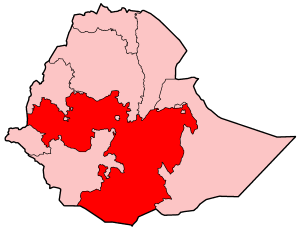

| OLA insurgency | |||||||
|---|---|---|---|---|---|---|---|
| Part of the Oromo conflict and Ethiopian civil conflict (2018–present) | |||||||
 Map of Ethiopia showing the Oromia Region | |||||||
| |||||||
| Belligerents | |||||||
|
| |||||||
| Commanders and leaders | |||||||
|
| |||||||
|
| |||||||
The OLA insurgency is an armed conflict between the Oromo Liberation Army (OLA), which split from the Oromo Liberation Front (OLF) in 2018,[6] and the Ethiopian government, continuing in the context of the long-term Oromo conflict, typically dated to have started with the formation of the Oromo Liberation Front in 1973.[7]
The Oromo conflict dates back to at least the formation of the Oromo Liberation Front (OLF) in 1973, evolving from the Bale Revolt that started in the 1960s in response to perceived injustices by the groups in power against the Oromo people.[7]
In August 2018, the OLF made peace settlements with the Ethiopian government,[8] along with several other groups, including the Ogaden National Liberation Front and Ginbot 7. The OLF leadership agreed to disarm its soldiers within 15 days of their arrival in Addis Ababa. According to then-OLF leader Ibsa Negewo, the OLF claimed to have 1,305 soldiers in Eritrea and 4,000 in West and South Oromia. The men stationed in Eritrea agreed to disarm but most of those in Oromia refused to do so despite their leaders’ wishes. One leader, Kumsa Diriba, also known by his nom de guerre as "Jaal Maro", failed to reach a deal with the government and after a falling out with the OLF, he split away from the OLF and formed OLF–Shene, also known as the Oromo Liberation Army (OLA). Security forces promised to crush the group within two weeks but haven't been able to do so even after 5 years of fighting.[9][10][11]
This section needs expansion. You can help by adding to it. (January 2023)
|
During the two years following its 2018 split with the OLF, the OLA killed 700 civilians in the East and West Guji Zones according to Haaji Umar Nagessa, a "veteran freedom fighter and tribal leader", who was assassinated by the OLA on 4 April 2020.[12]
On 29 May 2020, Amnesty International released a report accusing the security forces of Ethiopiaofmass detentions and extrajudicial killings. The report stated that in 2019, at least 25 people, suspected of supporting the Oromo Liberation Army, were killed by the forces in parts the Oromia Region. Between January and September 2019, at least 10,000 people were detained under suspicion, where most were "subjected to brutal beatings".[13]
In March 2021 during the Tigray War, a division of the Eritrean Defence Forces left the Tigray Region and arrived in the Oromia Region to fight against the Oromo Liberation Army (OLA), according to Freedom Friday.[14] On 11 August 2021, the OLA leader Kumsa Diriba (nom de guerre Jaal Maroo) announced that the group had formed an alliance with Tigray People's Liberation Front (TPLF) and that there were plans among opposition groups to establish a "grand coalition" against prime minister Abiy Ahmed, himself an Oromo.[15]
During Irreechaa celebrations in early October, protestors chanted against Abiy Ahmed and in favour of OLA commander Jaal Marroo.[16] By late October, the OLA controlled much of the former Wollega province.[17] On 31 October, the OLA took control of Kamisee in the Oromia Zone of the Amhara Region, at the same time as the Tigray Defense Forces took control of Kombolcha, about 50 kilometres to the north.[18]
On 1 November, OLA Commander-in-Chief Jaal Marroo said that the OLA had taken "several towns in western, central, and southern Oromia, facing little resistance from government forces who were retreating."[19]
During early and mid-November 2021, a TDF–OLA joint offensive took several towns in North Shewa zoneofAmhara Region along a major road leading south from Tigray Region to the Ethiopian capital Addis Ababa, appearing to threaten a military attack on Addis Ababa.[20]
Fighting between the OLA and Ethiopian government escalated during November 2022, as clashes between the two killed dozens. An alleged aerial attack killed many in the village of Bila in the West Welega Zone; battles between rebels and government forces in Nekemte followed this attack.[21] It was reported that the OLA seized control of Hamuma Gindo, Babu Dire, Becho, and Harbu kebeles, following clashes with militias there. Drone strikes against the rebels by the Ethiopian military occurred during that time. There were also reports of abductions and attacks against civilians by the OLA.[22] The OLA and Amhara militias clashed in Gutin during December, and both groups were reported to have attacked civilians during their conflict, with Amhara militias attacking civilians in Welenchiti, and the OLA attacking in Kiremu. Many of the Amhara militias have been identified as the Fano militia.[23]
|
Oromo conflict (1973–present)
| |||||||
|---|---|---|---|---|---|---|---|
| Background |
| ||||||
| Events |
| ||||||
| Topics |
| ||||||
| Groups |
| ||||||
|
| |||||||||||||||
|---|---|---|---|---|---|---|---|---|---|---|---|---|---|---|---|
| Background |
| ||||||||||||||
| Conflicts by region |
| ||||||||||||||
| Peace processes |
| ||||||||||||||
| Armed groups |
| ||||||||||||||
| Human rights organisations |
| ||||||||||||||
| Related |
| ||||||||||||||